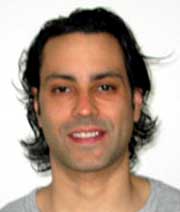 I usually try not to blog too often about the work of the same artist. But for some artists whose work i particularly appreciate, i just don’t try too hard. That’s why the name of Ricardo Miranda Zúñiga has popped up here and there in the blog. He creates both computer-generated art and sculptural vehicles to achieve powerful social metaphors that investigate issues of globalization.
I usually try not to blog too often about the work of the same artist. But for some artists whose work i particularly appreciate, i just don’t try too hard. That’s why the name of Ricardo Miranda Zúñiga has popped up here and there in the blog. He creates both computer-generated art and sculptural vehicles to achieve powerful social metaphors that investigate issues of globalization.
If you’re not familiar with his work yet, here’s a few projects he developed: Vagamundo, a video game that depicts the plight of new immigrants from Latin America to the US. The game goes right into the streets to directly meet its public in the form of a ice cream cart, similar to those pushed by paleteros in major U.S. cities.
Nexum ATM (2003) hides a comment on U.S. imperialism inside a standard ATM machine.
The Public Broadcast Cart is a shopping cart outfitted with all the technical ingredients that enables any pedestrian to become an active producer of an audio broadcast. The audio stream is available to anyone online and simultaneously transmitted via speakers making the cart a temporary soap box for willing participants.
But the project that won me is Dentimundo which offers citizens of the U.S., a wealthy country where 42 million people do not have health benefits, help in finding affordable dental care just across the Mexican border. The website documents this micro-economy of cross-border dentistry. I liked the project for several reasons: it’s very well documented, with plenty of humour, interviews and informative graphics. It opened my eyes on a reality i knew nothing of and added a new perspective on the Mexican/US border issue. Last reason is that i live in a country where dentists are still using tools and methods that come right from the ’50s, so i have to take a plane to Brussels whenever i have a toothache (which unfortunately happens quite often.) But enough with my life and back to Miranda Zúñiga‘s.

He grew up between Nicaragua and San Francisco. This bicultural background extended into his artistic practice — that investigates the divisive nature of capitalism and the social tools used to establish hegemony.
After receiving his MFA from Carnegie Mellon University in 1999, Ricardo Miranda Zúñiga started working at The College of New Jersey. He teaches Digital Arts, such as building interactive applications, Web Design and development (html, css, php, mysql, flash), computer graphics and so forth. In his second year there, he also introduced a Conceptual Art Studio class as a first year requirement in order to immediately introduce students to 20th Century avant-garde movements that may present intellectually rigorous and conceptually driven practices and -in his words- to get himself out of the computer lab.
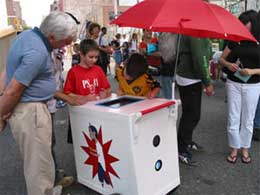 How did passersby react to a work like Vagamundo?
How did passersby react to a work like Vagamundo?
Several passersby have first asked me what flavor ice cream I had. When I tell them that I don’t have paletas but that I do have a free video game for them to play they are first surprised and then engage with the game or sometimes disappointedly continued on their search for a paleta. In general, children tend to immediately want to play the game and do so with no instruction. Adults however usually take some coaxing. Many will self-consciously try it out for a while, others will want to hear all about it, but then tell me that they are really bad at video games or wouldn’t know what to do.
Were the immigrants happy with the way you portrayed their situations?
Yes and no. The protagonist of Vagamundo is the Mexican comedian Cantinflas or Mario Moreno, an iconic character in Latin America. I used Cantinflas, because Latin Americans can immediately recognize the game as a comic or satirical portrayal of the downtrodden. In this manner, most Latinos in the know recognize that the game uses entertainment to portray a difficult reality. Cantinflas is also painted onto the sides of the cart itself, Latinos on the street, see this, are drawn to it and then laugh whenthey see an animated version of Cantinflas being controlled in a videogame and then want to play.
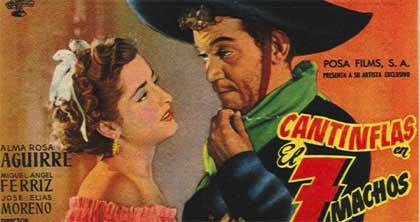 Poster of a Cantinflas movie
Poster of a Cantinflas movie
In researching the project I worked with the Tepeyac Association and interviewed many new Latin American immigrants to gather a diverse set of perspectives on getting into the United States and then life in the U.S. The game portrays an amalgamation of these personal perspectives, not as recent immigrants view themselves, but rather as others stereotypically view them. People who have experienced illegal immigration recognize this stereotyping and tend to agree that they are viewed in that manner.
Also when presenting the project, I target wealthy neighborhoods in which most non-affluent immigrants are behind a kitchen, walking a stroller, or tending a deli’s flower shop – they are hard at work, so not many new immigrant’s have played the game on the street. The overwhelming majority of pedestrian players have been upper middle class and white, this is the intended audience.
There was one instance, during a presentation at Columbia University’s MFA graduate studios that a two Latino students reacted negatively to the Cantinflas representation – to the fact that the protagonist at each level is slightly hunched over reflecting a subservient role. My response to them was that the project doesn’t seek to create a positive image of how far Hispanics have come in the United States, which is the cosmetic image that main stream media does choose to represent. Rather, I seek to put the viewer/player in a game that will have her/him reflect upon the intense hardships of undocumented Latino immigrants as part of our labor force in the United States.
Do you show the work regularly? Also in non-artistic contexts?
I haven’t shown Vagamundo in a couple years. When I first created the project, I primarily presented it at non-artistic contexts such as street festivals and randomly on sidewalks, in wealthy neighborhoods of Manhattan.
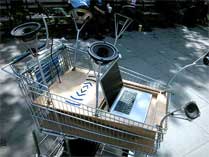
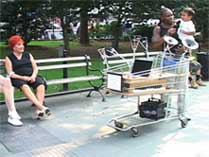 Another work that interacts with passersby in public space is the Public Broadcast Cart. The work invites pedestrians to become active producers of a radio broadcast. People are not used to undertake such an active role, are they willing to take the opportunity the cart offers? Do you get different kind of reaction according to the country or area where you show the Cart?
Another work that interacts with passersby in public space is the Public Broadcast Cart. The work invites pedestrians to become active producers of a radio broadcast. People are not used to undertake such an active role, are they willing to take the opportunity the cart offers? Do you get different kind of reaction according to the country or area where you show the Cart?
After having presented the Public Broadcast Cart in NYC, Linz, and Berlin, I’m convinced that high population density in Western cities creates a desire in individuals to be heard, to have their person or voice amplified. Whenever, I’ve made this project available in New York City, people immediately want to use it. The first time I presented it, I was most surprising. The Broadcast Cart was part of Wireless Park Lab Days, an NYC Wireless festival in Lower Manhattan’s City Hall Park. A man who had just finished his gym work out, anxiously awaited an opportunity to use the cart. Once it became available, he took over the cart and played emcee for the following two hours, pushing the cart throughout the park, interviewing people and generating discussion – public radio.
In Linz, people actively used it because it was presented in the framework of the Ars Electronica Festival, and people wanted to participate with the art. Also it was Ars 2004, two months before the second Bush election. Non-U.S. citizens were interested in discussing these elections, particularly with an artist from the United States. So I accompanied the cart to generate greater use. Ideally, The Public Broadcast Cart is a tool that others use without my monitoring or emceeing, this has been the case in NYC, but in other cities people are more likely to use it if I am present for introduction and discussion.
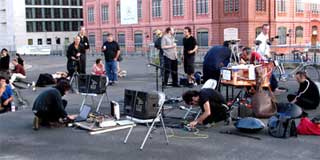 Whenever presented, mounted on the cart is text that introduces the function of the cart as well as a questionnaire appropriate to the time and place where it is presented. When pedestrians take the time to read these texts they tend to participate and allows me to step away. However in Berlin, it wasn’t getting much use, except by street
Whenever presented, mounted on the cart is text that introduces the function of the cart as well as a questionnaire appropriate to the time and place where it is presented. When pedestrians take the time to read these texts they tend to participate and allows me to step away. However in Berlin, it wasn’t getting much use, except by street
musicians and football fans. So with the help of a couple of friends Emanuele Guidi and Marco Barotti, we organized a public concert, Copa Sonar. The event featured five experimental sound and noise groups at a public plaza, Schlossplatz, a historically politicized and contested site that is currently largely abandoned except for skaters who have set up ramps on the plaza. Performances by ap/xxxxx, B Component, the rottt (the return of the thinking thing), OLYVETTY, and saal-c were broadcast from the site via miniFM and visitors were offered free wine and beer. It was a great summer evening, with a diverse audience of sound art connoisseurs, curious tourists, and skaters. And the performances were so good that if it wasn’t for the Internet, I’d produce a CD, all the performances are freely available:
http://www.ambriente.com/copa_sonar/
To return to your question, yes, in each instance, depending on country and context, the placement and reaction to the cart has varied.
I grew up in Belgium, in a city inhabited by many children of Italian and Moroccan immigrants. Most of them told me how they felt like they didn’t belong to any country in particular, neither Belgium nor Italy or Morocco. However i always felt so much envy for their “double identity”. Are you grateful for it or do you find it difficult to handle as well? How does your bi-cultural background feed your work?
I’m very grateful for my “double identity,” I think there was period when I had a hard time with it, but that was from the age of 14-16, long ago. Today, I enjoy traveling through Latin America where people assume I’m entirely Nicaraguan. Also much of my work is grounded in having grown up between the two countries and seeing the incredible differences.
The project that impressed me most is Dentimundo. It’s extremely well documented. What is its aim beyond being extremely informative? Isn’t the situation it exposes mostly a win-win one?
Dentimundo seeks to function as a creative documentary with a functional purpose (such as the list of licensed dentists that one may visit). It presents a win-win situation, however underlying the win-win situation are negative elements of capitalism and globalization that the project seeks to expose. Also in North America there are many people with misinformed perceptions of Mexico and its medical industry. The site with all its documentation seeks to expel some of these misconceptions.
 Most of your works investigate current sociopolitical issues. Some of them are sculptural vehicles, others are on screen. What is the respective power and/or role of these approaches? How do you decide which medium will best suit a particular issue?
Most of your works investigate current sociopolitical issues. Some of them are sculptural vehicles, others are on screen. What is the respective power and/or role of these approaches? How do you decide which medium will best suit a particular issue?
The decision as to what medium will best suit a particular issue depends on a variety of variables. I’m interested in creating work that combines aesthetics with critical perspectives but that is also somehow functional to others. So the decision of medium may depend on the community that the project targets, how the work can best be utilized by others, in what context it can establish the most powerful gesture or in what context it can establish a lively discussion…
Public Radio should be on the street and available for anyone to use, Upper East Side homeowners should acknowledge the reality of the kitchen staff who washes their dishes, and US citizens without medical or dental insurance should be aware of near by alternatives. Recently a Canadian emailed me with the following message: “Please Mention that Canada has NO dental insurance OTHER than private insurance that is VERY limited and virtually useless. The cost of Dentistry is on par with the United States and the situation is just as bad.”
In general, I prefer work that is not only on the screen. I enjoy unexpected situations in physical space, however information tends to travel best over the web. So I use the web to share my research and at
times for the project itself, after all, today many people in the United States are likely to look for a new dentist online.
Which pieces of advice would you give to artists who want to engage with social, cultural or political issues?
I think it’s important to carefully inform oneself of the various perspectives concerning issues in any public arena, and not through secondary or tertiary sources, but by actually speaking with people directly involved. In doing so, the work is likely to establish greater depth and sensitivity.
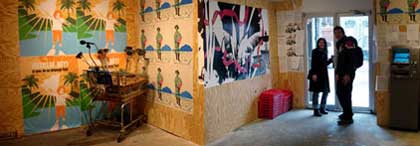 View of FALLOUT: What’s Left installation in Brooklyn
View of FALLOUT: What’s Left installation in Brooklyn
What are you working on now?
I’m reorganizing FALLOUT What’s Left for an installation in a branch of the Miami-Dade Public Library System, a branch in a predominantly Nicaraguan neighborhood. I’d also like to take all the submission to the FALLOUT website, along with the graphics, and research and translate it into book form. I feel that there are several submissions that are powerful and present personal histories and current perspectives that are ignored. A few of my favorite submissions are:
http://turbulence.org/Works/fallout/viewentry.php?user_id=30
http://turbulence.org/Works/fallout/viewentry.php?user_id=50
http://turbulence.org/Works/fallout/viewentry.php?user_id=36
I’m also starting a long term project concerning the social constructions behind the term and concept of freedom.
Any artist from Nicaragua whom you think should get more attention from the public?
I like the work of Ernesto Salmeron, a conceptually based artist that uses video, installation, and public intervention. He is currently investigating the erasure of Nicaragua’s revolutionary history. I also like the work of more established artists Patricia Villalobos and Patricia Belli.
